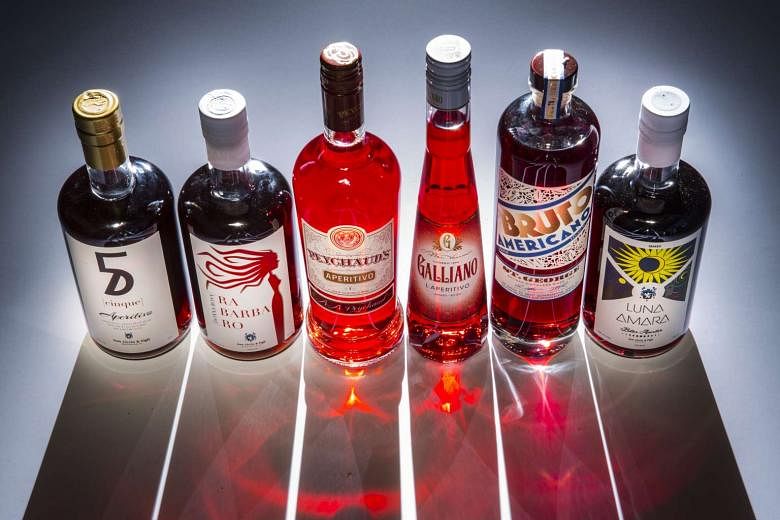NEW YORK (NYTIMES) - It is easy to see red when visiting Dante, a cocktail bar and restaurant in New York's Greenwich Village: So many of the bottles on display glow ruby and crimson and scarlet.
These bittersweet liqueurs, many from Italy but some not, are called bitters or aperitivos and are used in many of the light-bodied drinks that Dante makes its specialty.
Most visitors will recognise two bottles immediately: Campari and Aperol. Not long ago, they were largely the whole story. Today, however, they have been joined by a growing number of rosy rivals - including several from the United States - all vying for a spot in the next spritz or Negroni.
"We have seen a lot more entries in that category for really the first time," said Jana Ritter, the marketing manager for the Sazerac Co., which produces a wide assortment of liquors. Sazerac, based in Louisiana, decided to create its first aperitivo under the name of its popular Peychaud's Bitters (the kind of bitters you dash into a cocktail like the Sazerac). Peychaud's Aperitivo arrived in late 2015 and is now sold in more than 30 states and overseas.
Similarly, when Galliano, the gold-hued Italian liqueur in the long, narrow bottle, decided it was time for a new version, the result was red and bitter: Galliano L'Aperitivo, which it introduced to the United States in May.
"We brought it in to catch the momentum of the summer menus," said Tanya Cohn, the company's brand manager. "American consumers are open to more and more bitter flavours."
Indeed, bitter cocktails like the Negroni, which calls for Campari, and the Aperol spritz have soared in popularity, partly because young bartenders share their love of acerbic flavours with their customers. In the past five years, U.S. sales of Campari have grown to more than 110,000 cases annually, from 50,000, said David Karraker, vice president for marketing of Campari America. Sales of Aperol, which is owned by Campari, have nearly doubled to 67,000 cases last year, from 35,000 in 2013.
America has never had much of a tradition of producing aperitivos, but it is developing one. Craft distillers like St. George Spirits in Alameda, California; Don Ciccio & Figli in Washington; and Leopold Brothers in Denver have each created an aperitivo in the last few years. Though all these new drinks share a yin-yang bittersweet personality, flavours can vary surprisingly, depending on alcohol levels, the array of botanicals in the mix and the power of the bittering agents.
None of these distillers expect to get rich hopping on the Campari train.
"If your goal is to just make bitters, don't quit your day job," said Lance Winters, the master distiller of St. George, which makes the aperitivo Bruto Americano.
Still, they see an opportunity. "We ask people to taste them side by side," said Francesco Amodeo, president and master distiller of Don Ciccio & Figli, which makes three aperitivos, including Luna Amara.
"Make a Negroni with Campari and make a Negroni with Luna." Still, he says he wanted to create a new drink without necessarily doing battle with Campari. "Campari is why we're here," he said.
Todd Leopold, of Leopold Brothers, thinks there is room on the shelf for everyone. "We're hoping more and more people get interested in the category as a whole," he said. "Then they're going to look for more expressions and regional expressions. I don't see it as a zero-sum game."
Talia Baiocchi, a wine and spirits writer and co-author of the 2016 book Spritz, agreed. "There's room, and demand, for more diversity," she said, "so I do think we'll continue to see new, or at least new-to-market, red bitter brands find a permanent place at the country's top bars."
That is fine by Karraker, of Campari America. "It calls even more attention to the originals," he said.
"Of course," he could not help but add, "there is only one Campari and only one Aperol."

